Whether your investor resume needs a complete makeover or just a couple of small adjustments, you're in the right place!
Comprehensive, yet easy-to-follow — our guide is here to help you pen a compelling resume that sells all your best skills and qualities to potential employers. Inside, you'll find thorough examples, sleek templates, useful tips, and samples submitted by actual investment professionals. So, let’s make your resume impossible to overlook one step at a time!
Keep on reading to learn how to:
- Choose a resume format that matches your experience level
- Craft an attention-grabbing investor resume summary
- Write a skills section that reflects all your best skills as an investor
- Describe your investor work experience in detail
- List your academic credentials in your investor resume
- Pick the perfect optional sections for your investor resume
- Access top resources for job-seeking investors
Still looking for a job? These 100+ resources will tell you everything you need to get hired fast.
1. Choose a resume format that matches your investment experience level
Firstly, it's important to choose a resume format that best reflects your experience level. This step is more than just a stylistic choice — it's a strategic way to accentuate your strengths, while drawing the recruiters’ attention away from your weaknesses.
For the sake of clarity, let's discuss only the three most commonly used resume formats. Based on your experience level, you can opt for:
- Chronological format: The name “chronological format" is quite self-explanatory. This type of resume puts your work experience section front and central, while organizing your entries in a reverse-chronological order. This format is best suited for those with continuous, long-term work experience in a specialized position.
- Functional format: A functional resume puts emphasis on your skills, education, and certifications rather than your work experience. As such, this format benefits anyone who lacks relevant practical experience, for example, fresh graduates, job-hoppers, career-changers, or those with employment gaps.
- Hybrid format: Finally, a hybrid resume combines both of the two former formats to create a document that evenly spreads its focus amongst all sections. It allows you to give equal weight to your education as well as professional experience.
Regardless of which resume format you go for, remember to stay consistent in its formatting. Use appropriate fonts, professional section headlines, and easy-to-read layout throughout.
The best way to ensure consistency and professional formatting of your investor resume is to use an expertly crafted resume template.
2. Craft an attention-grabbing investor resume summary
Once you've picked your resume format, it's time to move to your resume summary.
Sitting at the top of the page, right beneath the header with your contact information, a resume summary serves as a teaser inviting the recruiters to read the rest of your resume. In just 2-4 sentences, you should communicate your key achievements, unique skills, or qualifications that make you the best fit for the job.
Below, you'll find two examples of resume summary, a bad one and a good one, together with a brief explanation:
Bad investor resume summary example
An investor with many years of experience. Worked for several different companies and achieved considerable successes. I have all the best skills and knowledge you're searching for.
What makes this summary so bad? The main culprit here is vagueness. Your resume summary should be short but punchy, containing the very best of your credentials. Remember, the purpose is to make the recruiters pay attention to the rest of your resume, not to be mysterious.
Good investor resume summary example
Highly analytical investor with 7+ years of experience in portfolio management and equity research. Graduated magna cum laude with a M.A. in Finance, further gained a CFA certification. Successfully managed a diversified investment portfolio exceeding $50 million, consistently outperforming the S&P 500 by 15% annually through rigorous quantitative analysis and market trend evaluation.
What makes this resume summary example so good? This example manages to highlight the candidate’s lengthy professional experience, education, as well as certification. Additionally, their major professional accomplishments are bolstered by concrete numbers.
Keep in mind that your resume summary is responsible for making the first impression. Introduce yourself to the recruiters with a bang and show them exactly what sets you apart from other candidates.
3. Write a skills section that reflects all your best skills as an investor
The world of finance and investment calls for a very specific set of skills. And the skills section of your resume is the most sensible place to list them.
But this can't be done at random! As always, you must be strategic about what to choose to include and what to omit. When tailoring your resume to a specific job posting, make sure to include the skills the ad actually asks for in its job description and requirements parts.
Based on their nature, your skills can be divided into two groups:
- Hard skills: Hard skills are specific and measurable abilities that can be taught through courses or formal education. These may include language proficiencies, financial analysis tools and methodologies.
- Soft skills: On the other hand, soft skills refer to how you carry yourself in the workplace and interact with others.
Here are examples of hard and soft skills relevant for all investors:
Best hard skills for an investor resume
- Financial analysis
- Quantitative analysis
- Risk management strategies
- Market research
- Regulatory knowledge
- Investment software and platforms
- Portfolio management
Best soft skills for an investor resume
- Critical and analytical thinking
- Quick decision making
- Adaptability
- Strong communication
- Attention to detail
- Negotiation
- Networking
PRO TIP: If the company you're applying for uses an Applicant Tracking System (ATS), spell all your skills exactly as they appear in the job posting. This will ensure maximum compliance with the ATS.
To be a well-rounded investor, you need to have a delicate blend of both hard and soft skills. Listing the right skills demonstrates that you have a full understanding of what the position entails. So, take this opportunity to show your potential employers what you bring to the table!
4. Describe your investor work experience in detail
The work experience section is the heart and soul of any chronological resume.This is the part potential employers are most curious to see. It's also your chance to showcase how you utilized your skills in a real-life professional setting, when faced with specific problems.
A good work experience entry should follow this structure:
- Job title
- The name of the company and the period of employment
- A list of bullet points capturing the most relevant and impressive accomplishments and results.
An example is worth a thousand words, so let's have a look at two model work experience entries and assess their execution:
Bad example of an investor resume work experience section
Investment associate, XYZ Corp.
June 2020-Present
- I used to handle various investment projects in a range of sectors.
What's wrong with this example? Almost everything. It fails to show any particular achievements or results. It’s vague, nondescript, and doesn't show anything that would make employers want you in their organization.
Good example of an investor resume work experience section
Investment associate, XYZ Corp.
June 2020-Present
- Led the analysis and due diligence of over 100 potential investment opportunities, leading to the successful acquisition of 15 high-growth startups, which collectively enhanced the firm's portfolio value by 35% within 3 years.
- Developed and implemented a comprehensive risk management framework, reducing portfolio volatility by 25%.
- Initiated and nurtured strategic partnerships with venture capital firms and industry experts, resulting in an annual deal flow increase of 20%.
- Led a cross-functional team in the development of a proprietary investment evaluation tool that streamlined the analysis process, cutting down evaluation time by 40%.
Why does this example work? Each bullet point starts with an action verb, saving precious space and making the candidate sound proactive. The bullet points are structured to highlight a specific skill and the results it brought. Furthermore, using quantifiable achievements wherever possible underlines the value this candidate added to their past employer.
Just like with the skills section, you want your work experience section to align with the needs of your target company as closely as possible. When choosing which achievements to mention in your work description, try to cater to specific requirements outlined in the particular job posting.
To really drive all your points home, we recommend using specific examples, starting your bullet points with action verbs, and adding quantifiers if relevant.
5. List your academic credentials in your investor resume
Generally speaking, employers expect their investors to have at least some degree of formal tertiary education. A degree in finance, economics, financial markets, financial modeling, statistics, or other related fields can give you a solid foundation.
In any case, your education section should be as concise as possible. Besides, information, such as the name of your degree, the name of the institution, and years of study, you can also add notable acknowledgments or awards if relevant.
Investor resume education section example
Master of Science in Financial Markets
University of Economics, Prague
2015 - 2017
- Graduated with honors
- Presented thesis findings at Student Finance Conference.
A well-written education section offers further insight into your formal qualifications. Even though this isn't necessarily the most significant part of your investor resume, you still need to include it for the sake of conventions.
6. Pick the perfect optional sections for your investor resume
Besides the expected resume sections, you can also add optional sections. Why include them? Well, in the sea of candidates with very similar resumes, you need to seize every opportunity to stand out. Just remember to tailor them to showcase your strengths, experiences, and qualifications that align with the job position.
Based on your particular needs, you can add sections dedicated to your:
- Certifications: Adding certificates that vouch for your knowledge, skills, or expertise relevant for the job increase your value in the eyes of potential employers. Your investor resume would only benefit from certificates like Financial Risk Manager (FRM) or Chartered Financial Analyst (CFA).
- Volunteering: Including a volunteering section on your resume is a great way to show your alignment with company values, in case your potential employer is also interested in social issues.
- Personal projects: Mentioning projects that you took on outside of your normal employment suggests that you have a genuine passion for investment, as well as your dedication to the craft.
Optional investor resume sections examples
Certifications
- Certified Financial Planner (CFP)
- Chartered Alternative Investment Analyst (CAIA)
Volunteer experience
Volunteer Financial Analyst, Global Health Initiative
March 2020 - August 2020
- Provided pro bono financial analysis and strategic advice to a global health initiative focused on improving healthcare access in developing countries.
- Conducted financial modeling and risk analysis to assess the feasibility of various program initiatives and funding opportunities.
Personal projects
- Financial blog and Investment research platform: Founded and manage a financial blog and investment research platform aimed at providing educational content and analysis for individual investors.
Optional sections like these can offer additional context to your professional life. This makes it the perfect opportunity to inject a bit of personality into your resume.
7. Top resources for job-seeking investors
You've made it here, which means that now you know how to make an investor resume that can impress even the most demanding recruiters. But do you know which recruiters to impress?
Looking for the right work opportunities isn't always as straightforward as we'd wish it to be. But these resources can serve as an inspiration for your very own job search:
- Industry-specific job boards: Websites with niche focus like Morningstar Careers, eFinancialCareers, or Bloomberg Careers can be great entry points to the world of finance.
- Online job search engines: Next, you can search through platforms with broad focus such as Indeed, Glassdoor, ZipRecruiter, or SimplyHired.
- LinkedIn: Apart from its job search tools, LinkedIn gives you the perfect opportunity to connect with fellow investment professionals and potential employers alike. Networking makes the investment world go round!
- Professional associations: Besides job listings, associations and organizations like the Chartered Financial Analyst Institute (CFA), the Certified International Investment Analyst Association (CIIA), and the Alternative Investment Management Association (AIMA) can offer you access to networking events, further training, and the latest industry news.
- Specialized publications: Keeping up-to-date with the latest industry developments, financial trends, strategies and news can give you the competitive edge you need to succeed. Consider following media such as “The Wall Street Journal,” “Financial Times,” “InvestmentNews,” or “The Economist.”
- Continuous learning: As an investor, you're always a work in progress. To continue sharpening your skills, you may want to take on new challenges. Find the best courses that fit your goals with online learning platforms like Coursera, edX,LinkedIn Learning, or Udemy.
Remember, job offers won’t land in your lap just like that. It's you who has to do all the hard work! So gear up, be proactive, and keep your eyes peeled for suitable opportunities at all times.
And don't forget to keep updating your resume as well as your investor cover letter. After all, if you craft them both with care, these two documents can do some considerable heavy lifting for you. Good luck!
Investor Resume FAQ
Any tips on how to show off my skills in an investor resume?
Show, don’t tell! Instead of simply writing the phrase "analytical thinker" into your skills section, try to include an example of a real-life situation in the job description of your work experience section. Make sure to mention what skills and knowledge you utilized, and what result you achieved. For example: “Conducted quantitative analysis of investment opportunities, utilizing advanced financial modeling techniques to assess risk and return metrics, resulting in a 15% improvement in portfolio performance."
What common mistakes should I avoid?
By far the worst mistake you can make is NOT customizing your resume to fit the description of the job posting you're applying for. Other common mistakes include: misspellings, grammar mistakes, typos, generic phrases, and filler words. But all of these details can be smoothed out by careful proofreading.
I'm submitting my job application via ATS. What's the best way to use keywords in my investor resume?
Remember that effective keyword use isn't about overstuffing your resume with the most words from the job description. Instead, sprinkle these naturally throughout your resume when writing about your skills, experience and qualifications descriptions. And make sure to spell them exactly as they appear in the job posting!
How much work history should I include in my investor resume?
Generally, focus on the last 10-15 years of your career. Older positions can be summarized under a header like "Prior Professional Experience." But remember, content relevance matters more than chronological order. Your headline-making deal from 16 years ago? It definitely deserves a spotlight! But the usual practice is to go into greater detail on your last 2-3 positions.
How should I handle 'gaps' in my work history on my resume?
In such cases, honesty is the best policy! But context also matters. So, rather than just leaving a blank space, address the gap and put a positive spin on it. Did you take time off for personal development, volunteer work, or learning a new investment strategy? Show how you spend the time off in a productive way. You can also address this in your cover letter.

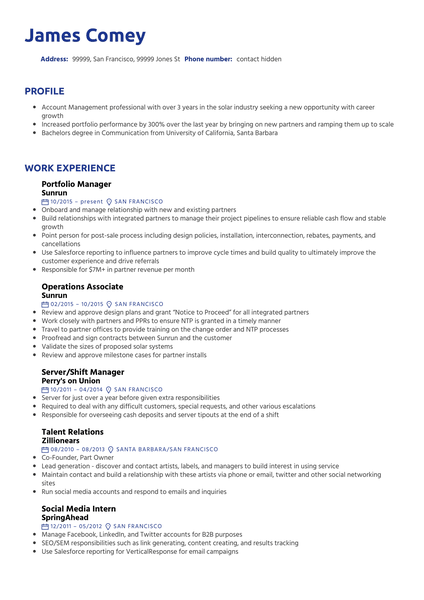

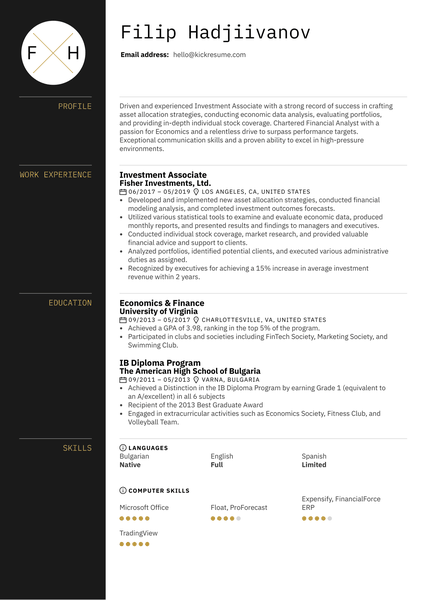
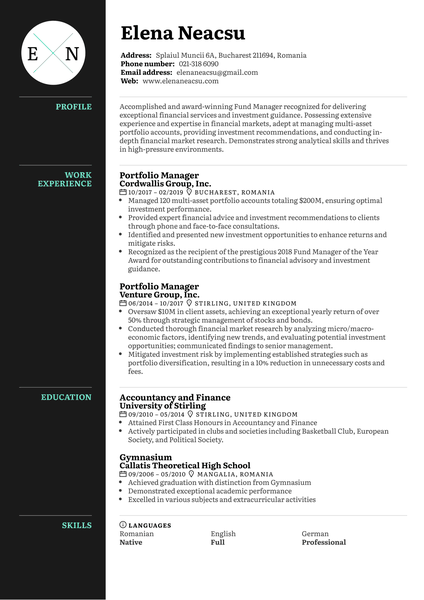
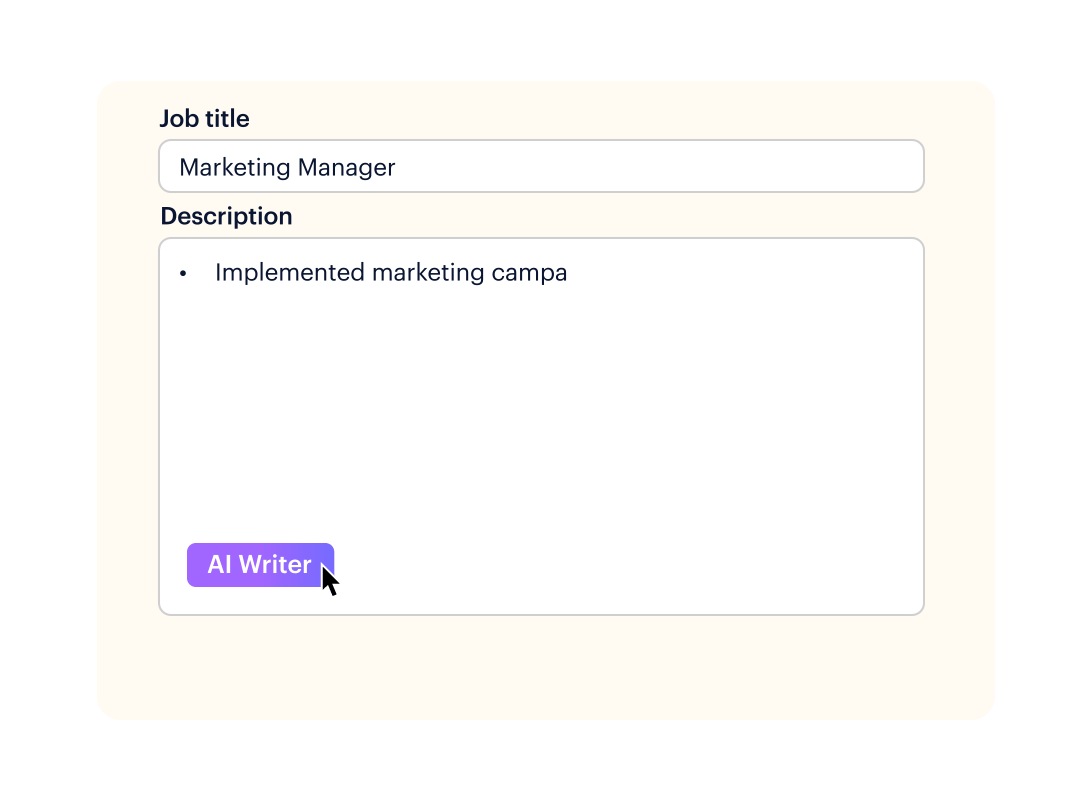


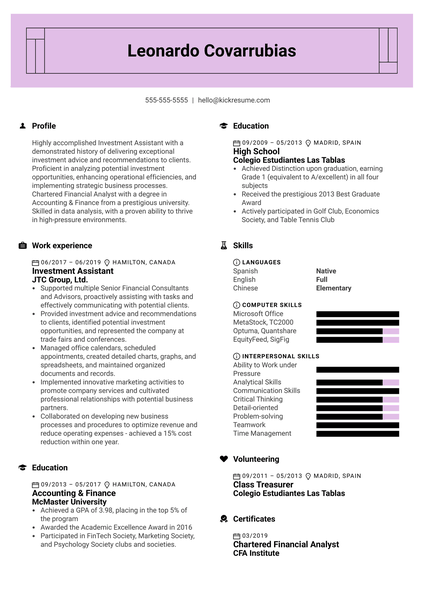
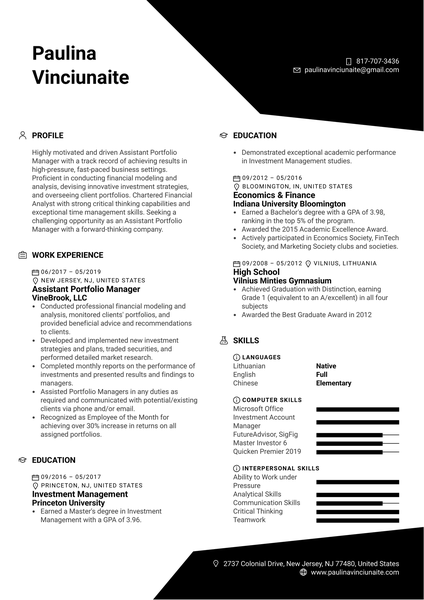
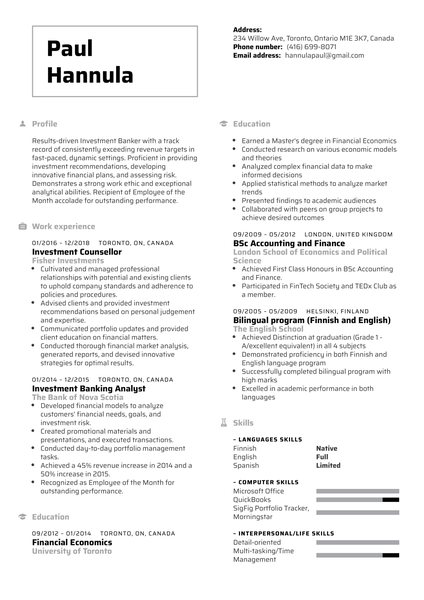

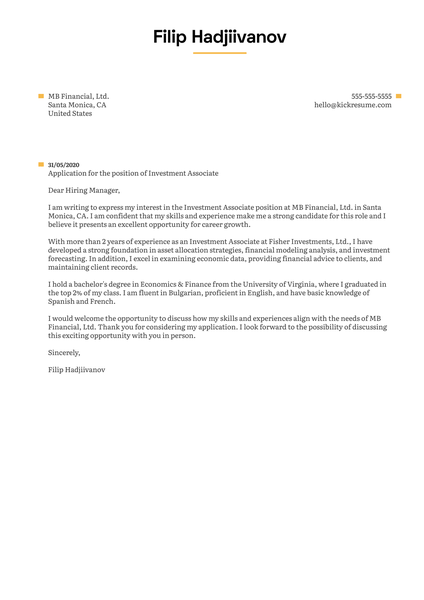

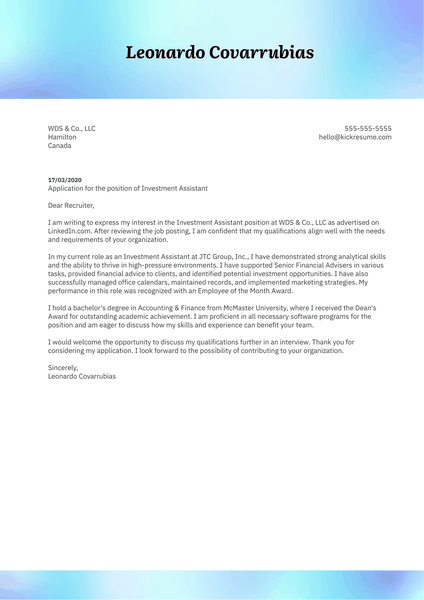

![How to Write a Professional Resume Summary? [+Examples]](https://d2xe0iugdha6pz.cloudfront.net/article-small-images/i-Profile.svg)
![How to Put Your Education on a Resume? [+Examples]](https://d2xe0iugdha6pz.cloudfront.net/article-small-images/i-Collage-Universities.svg)
![How to Describe Your Work Experience on a Resume? [+Examples]](https://d2xe0iugdha6pz.cloudfront.net/article-small-images/Experience.svg)


